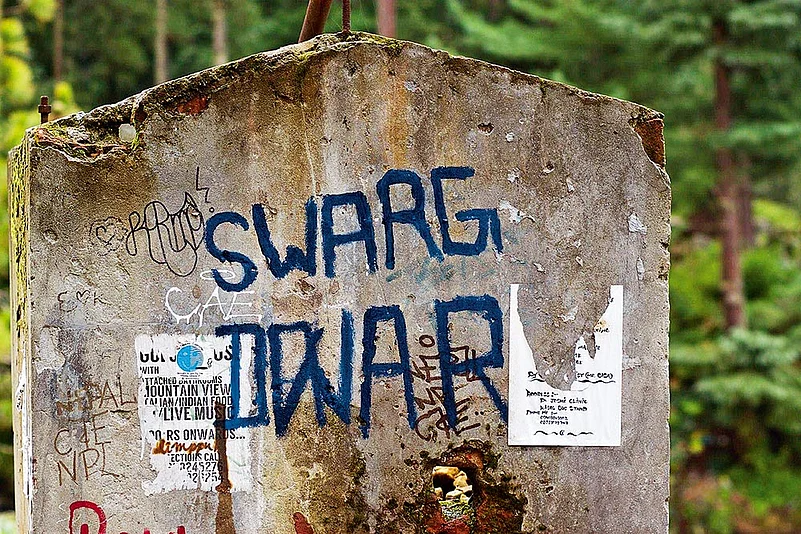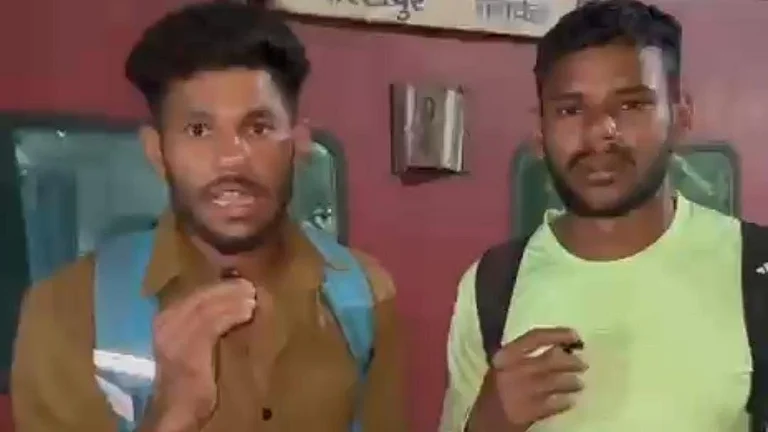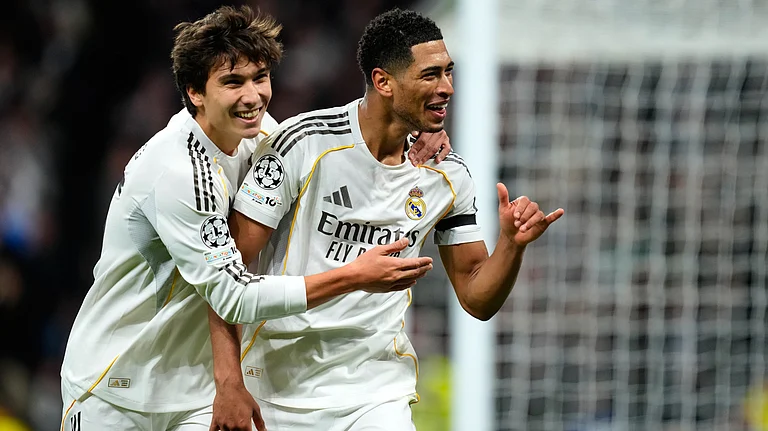The competition for imagining how the world will end is fierce. You’ve got the Occidental models of Hell, Armageddon, the Gotterdammerung, aka the twilight of the gods, and so on. Then you have the many different world-ending myths from the ancient cultures of the Americas, Africa and Australasia. Closer to home, we have the whole idea of pralay, which carries a multiplicity of meanings, including both dissolution and destruction. When I was a kid, the way pralay was explained to me by my grown-ups definitely involved the sense of a massive, world-swallowing earthquake. This ultimate vinaash was described with great relish and in minute detail but often quite cheerfully, as if this were the natural order of the cosmos and—along with the birth of the universe— something to be celebrated. Looking back now, I understand the cheerfulness differently.
People of my parents’ generation had seen a tumultuous freedom struggle, a devastating World War that must have felt both unpredictable and interminable as you lived through it, the crippling famine in Bengal with attendant smaller famines in other parts of the country, the earth being ripped asunder by the horrors of Partition, and then the birth pangs of a Republic of sorts clawing itself into traction. As they laid out the orgy of the imagined final destruction—in a universe where nothing was ever final but always cyclical—the ongoing Cold War and the very real threat of nuclear war would have lurked in their consciousness.
However, in that decade of the ’60s, as a middle-class urban Indian nuclear family, we were living through a period of comparative calm and prosperity: both my parents were earning, we never lacked for food, the two-bedroom flat we rented had good light and sanitation, we had people working for us in the house, we had a functional second-hand car; after several generations of education in the family, we had far more cultural (and caste) capital than financial, but this would stand kids like me in good stead, providing a solid launchpad from which one could capture larger amounts of money and even greater cultural and artistic influence. It would have been perfectly logical, therefore, to subconsciously feel that the worst you were going to see in your life was already behind you, that whenever the end of the world might be coming it wasn’t coming any time soon. This in turn would have lent the imagining of the final pralay the qualities of a game, of playful projections, with which to (only slightly) frighten the wide-eyed kid listening to you. Whatever the detailing of the projection, the sub-text would have been ‘the world may actually end someday’ but it’s not something you will experience in this janam, so don’t worry too much, this is just a philosophical jeu d’espirit’.

Photographs: Chinki Sinha
What might have been very real in the mind of any thinking adult at the time would be the awareness that every period of history holds in its core the seeds of its own end, which are also the seeds of the next and future periods to come. The adult might have thought about this but she would not necessarily have known which the seeds were, that would bring about upheaval and replacement. And, while change, even radical change, might have been foreseeable, an apocalypse that didn’t involve thermonuclear war would have been difficult for them to imagine.
ALSO READ: Song Sung Blue: The End As A New Beginning
Looking back, you can drop different analyses on the first thirty years of the Republic, the choices made by the political leadership, the trajectories the different societies that make up ‘India’ allowed themselves to take, or were pushed into taking, and how external factors from around the world affected all of these. No matter what your choice of antidote might be in hindsight, one thing stands out: the toxic mountain of inequality bequeathed to us by casteism, feudalism and British imperialism, which remained unshifting, seemingly impossible to break down. Almost everything that ails us today was contained in the layers of this massif, the DNA of deprivation being passed on from generation to generation, the continuing absence of any real education for a majority of Indians, (with the religious and caste sectarianism that comes with such an absence), the abysmal lack of healthcare, the utter lack of any awareness of how we were crippling our environment in the hunt for a ‘development’ that conceptually remained oscillating between the models of the Western ‘free market’ or the Communist bloc.
***
I’ve spent the best part of the last two years in the flat my parents left me, which is a bit bigger, much more comfortable and centrally-located in the city than the apartments we rented across my childhood. Unlike the tall residential blocks that came up around us later, our building is small, with only nine flats. When the pandemic began, my personal situation meant I needed to stay put in my house and I did this, imagining that the crisis would be over in two or three months. As the foolish optimism of this projection became clear I began to feel trapped; as the pandemic further tightened its grip, I realised I was hugely fortunate in always having ‘worked from home’, in a sense, and to have a comfortable home from which I could work while staying connected to the world.
ALSO READ: The Four Horsemen Of Apocalypse
When the approach of Covid became clear, I went and brought extra supplies. When the lockdown was suddenly declared I witnessed the horror of thousands of families walking home to their villages in the heat, but at a huge remove. When the leader of a supposedly developing country in the 21st century asked people to beat thaalis and blow conch shells at a specific time of a certain evening, I stood on my balcony, watching and listening to dozens upon dozens of educated, privileged people banging their vessels and shouting slogans, the cacophony bouncing off the roofs of the high-end cars parked below, cars that could, suddenly, go nowhere.

No one had promised that the end of the world would come on a fixed trajectory and schedule. As the horror unfurled, it played cat and mouse with us. The traffic disabled, the air around one of the most polluted crossings of the city, just outside my building, turned clean within three days. You could breathe in the fragrance of the flowers on the trees that stood between the buildings; you could hear all sorts of bird-song. A friend who I loved but hadn’t seen in a while lived in another part of the city, a bit far away. He was in his late sixties, with no serious health issues. His wife took him to hospital with a low fever and a sniffle and he was dead within six days. He had worn some sort of mask and ‘just gone to the market for a quick shop’. He was the first of several friends the plague would take. The death count began to rise across the country. One evening, at the exhortation of the leader, most of the lights were put out in the buildings in the neighbourhood. I watched floor upon floor of people flashing their phone torches to scare away the virus.
ALSO READ: Meowdi: A Short Story by Perumal Murugan
Going out, I diligently wore my N95 mask. Many people looked at me as though I was some sort of stupid alien landed from another planet. Some of us organised masks for the people working in the building, but you could see the masks didn’t make any kind sense to most bodies who had to live and work in the sweltering heat in the compound below or on the roads outside. One by one, people living in the high-rises started to get the infection but few people bothered to inform or protect the staff working for them; precautions were clearly only for those above a certain income bracket. Two or three of the staff went back to Bihar just as the pandemic finally reached the villages and began taking its toll. Once back, these returnees didn’t need to be reminded about proper masking—they now understood the gift the upper-classes and international travellers had sent the rest of India. Friends’ parents began to die. Many of them died of natural causes, but their last moments were in isolated wards, their final goodbyes conducted on video-calls. The deep atomisation and cutting off from the rest of the country that we, India’s upper-middle classes, had embraced was now engulfing us in horrifying ways.
In the summer, the Chinese decided to capture a hundred square kilometres of Indian territory and our leaders found they had no need or ability to resist any such takeover. A bit later the same brave leaders decided to ram through atrocious farm laws in Parliament without any debate; and the farmers set up a remarkable, heroic resistance. The year 2021 brought election fever to add to the fever surging across the country. Even as the Delta variant scythed into the population of north and west India, West Bengal reached what many called ‘a civil war situation’, with the country’s ruling party and its subservient authorities on one side, and the local party and local administration on the other. In the meantime, the Ganga began carrying corpse-flotillas in a state where there was ‘no shortage of oxygen’ and no dead body had been slid into the river because there was no shortage of pyre-wood or space in the burning grounds. Those very real corpses floating down that very real, very soiled holy river would fit into ancient imaginings of dissolution and destruction but the outright lies trotted out in denial, whether on TV or in court, are a part of a very contemporary hell, a very Indian narak.
ALSO READ: Gods, Bots And The New World Order
***
There is going to be no pralay as we have imagined in our conceptions of the apocalypse as a single mythic event. There is going to be no ‘post-pandemic’ world in the sense of any neatly divided befores and afters—after the World Trade Centre and the contiguous wars we have lived in a constant 9/11 and ‘war on terror’ reality. In places like Afghanistan, Iraq and Syria this reality has been nothing short of apocalyptic. Those man-made, mini-Apocalypse events changed our lives and will stay with us for some decades to come. Covid-19, whether a biological freak event, lab accident or man-made assault on mankind, has also been soldered on to the previous disasters by both circumstance and human agency.

Once a manufacturer or seller still gets buyers after raising the price of a product you rarely see the price tag going lower. Similarly, once the powers that-be know what they can make us do under the fear of terrorism or of sudden disease and death, those instruments of control stay hovering over us till some other cataclysmic event shifts the matrix. Once suspicion, othering and division have been inserted into the crevices of society, it is very difficult to stop these things from widening the rifts between sections of people. This is something we are now seeing across the world. To this, in India, we have to add toxic religiosity and the delusionary idea of a macho India straddling the international stage as a ‘world power’.
ALSO READ: The Good Earth: Resilient And Resourceful
When a naked emperor is allowed to preen his non-existent finery long enough, his courtiers and worshippers also find the inspiration to divest themselves of all self-awareness and drape themselves in nothing but self-delusion. This means that in the mirror you see yourself as a citizen of a country that is suddenly feared and respected, a vishwaguru, no less, whereas actually you are the laughing stock of a world that’s watching your humiliating decline, stifling its horrified guffaws out of diplomatic politeness. A narcissistic, power-hungry, truth-hating regime such as this is perfect for presiding over a nation-destroying, society-smashing pralay. The thing we have to understand is that this dystopian dance will be danced in slow motion and the pain will last across many years. What they neglect to tell you when you’re a kid is that the length of our punishment is part of the i.
(This appeared in the print edition as "End of Days")
(Views expressed are personal)
ALSO READ
Ruchir Joshi is a writer, columnist and filmmaker based in Calcutta


























